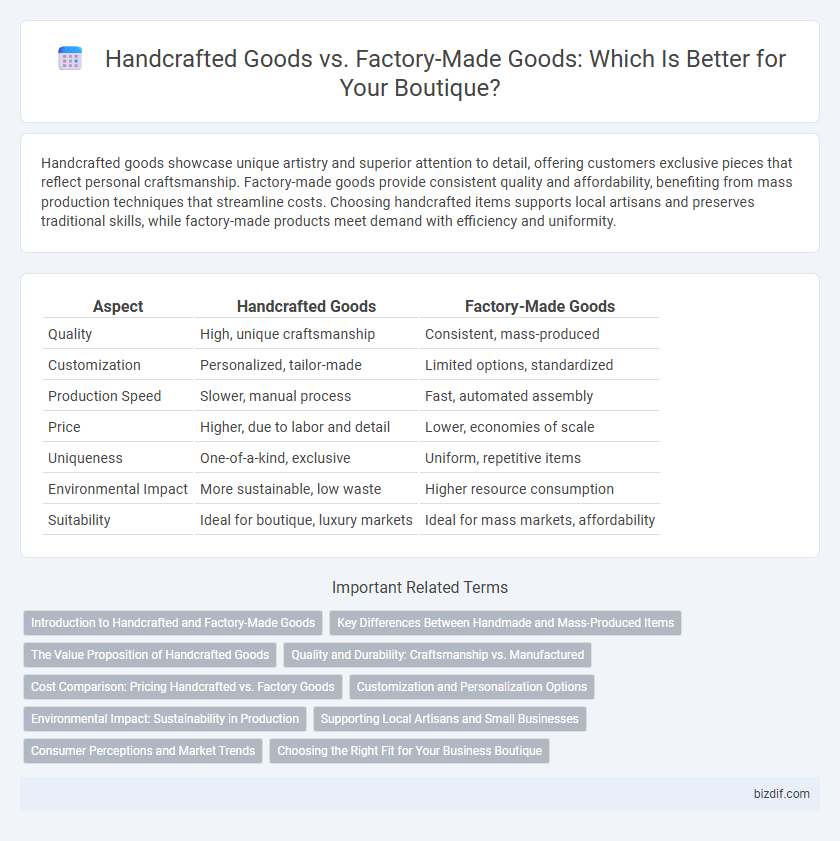Handcrafted goods showcase unique artistry and superior attention to detail, offering customers exclusive pieces that reflect personal craftsmanship. Factory-made goods provide consistent quality and affordability, benefiting from mass production techniques that streamline costs. Choosing handcrafted items supports local artisans and preserves traditional skills, while factory-made products meet demand with efficiency and uniformity.
Table of Comparison
| Aspect | Handcrafted Goods | Factory-Made Goods |
|---|---|---|
| Quality | High, unique craftsmanship | Consistent, mass-produced |
| Customization | Personalized, tailor-made | Limited options, standardized |
| Production Speed | Slower, manual process | Fast, automated assembly |
| Price | Higher, due to labor and detail | Lower, economies of scale |
| Uniqueness | One-of-a-kind, exclusive | Uniform, repetitive items |
| Environmental Impact | More sustainable, low waste | Higher resource consumption |
| Suitability | Ideal for boutique, luxury markets | Ideal for mass markets, affordability |
Introduction to Handcrafted and Factory-Made Goods
Handcrafted goods are produced through skilled manual labor, emphasizing artistry and unique details in each piece. Factory-made goods utilize automated processes and machinery to achieve high-volume production with consistent quality and standardized designs. This distinction highlights the value of craftsmanship in handcrafted items compared to the efficiency and uniformity found in factory-made products.
Key Differences Between Handmade and Mass-Produced Items
Handcrafted goods feature unique, artisanal qualities and meticulous attention to detail, often crafted from high-quality materials that emphasize durability and individuality. Factory-made goods benefit from standardized production, resulting in consistent quality, affordability, and widespread availability but typically lack the personalized touch inherent in handmade items. The key differences lie in production scale, craftsmanship, material sourcing, and the exclusivity associated with each product type.
The Value Proposition of Handcrafted Goods
Handcrafted goods offer unique, artisanal qualities that factory-made items cannot replicate, providing a personalized touch and superior craftsmanship. These products often utilize high-quality materials and traditional techniques, enhancing durability and aesthetic appeal. Consumers value the authenticity and exclusivity of handcrafted items, which support local artisans and promote sustainable, ethical production practices.
Quality and Durability: Craftsmanship vs. Manufactured
Handcrafted goods from boutiques exhibit superior quality and durability due to meticulous craftsmanship and attention to detail, ensuring each piece is unique and long-lasting. Factory-made goods often rely on mass production techniques that prioritize quantity over precision, resulting in uniform but less durable products. The artisanal approach values material selection and manual skill, which enhances both the aesthetic appeal and structural integrity compared to manufactured alternatives.
Cost Comparison: Pricing Handcrafted vs. Factory Goods
Handcrafted goods often carry a higher price tag due to labor-intensive production, unique craftsmanship, and limited supply, contrasting with factory-made goods that benefit from economies of scale and automated processes, resulting in lower costs. The premium pricing of artisan products reflects quality materials and personalized design, while factory items prioritize uniformity and mass production efficiency. Consumers pay more for handcrafted items because they receive exclusivity and superior detail that factory-made goods typically cannot replicate.
Customization and Personalization Options
Handcrafted goods offer extensive customization and personalization options, allowing customers to request unique designs, materials, and finishes tailored to their preferences. In contrast, factory-made goods typically provide limited customization, often restricted to predefined variations or sizes. This distinction makes handcrafted products ideal for consumers seeking exclusive, one-of-a-kind items that reflect personal taste and individuality.
Environmental Impact: Sustainability in Production
Handcrafted goods often have a lower environmental impact compared to factory-made goods due to minimal energy consumption and reduced waste during production. Artisans typically use sustainable materials and traditional techniques that promote resource efficiency and reduce carbon emissions. In contrast, factory-made goods frequently rely on mass production processes that contribute to higher pollution levels and greater resource depletion.
Supporting Local Artisans and Small Businesses
Handcrafted goods from local artisans offer unique, high-quality designs that reflect cultural heritage and personal craftsmanship, contrasting with the uniformity of factory-made products. Supporting small businesses fosters community economic growth and encourages sustainable manufacturing practices that reduce environmental impact. Choosing handmade items empowers artisans, preserves traditional skills, and sustains regional economies through ethical consumerism.
Consumer Perceptions and Market Trends
Handcrafted goods are perceived by consumers as unique, high-quality products with a personal touch, often commanding premium prices in boutique markets. Factory-made goods, while consistent and cost-effective, are viewed as mass-produced and less exclusive, appealing to price-sensitive buyers. Market trends show a growing demand for artisanal craftsmanship, driven by consumers valuing authenticity and sustainability in boutique shopping experiences.
Choosing the Right Fit for Your Business Boutique
Handcrafted goods offer unique, high-quality items that can enhance the boutique's brand identity and attract discerning customers seeking exclusivity. Factory-made goods provide consistency, scalability, and cost-efficiency, ideal for boutiques aiming to maintain competitive pricing and meet high demand. Selecting the right fit depends on the boutique's target market, brand values, and long-term business goals.
Handcrafted Goods vs Factory-Made Goods Infographic

 bizdif.com
bizdif.com